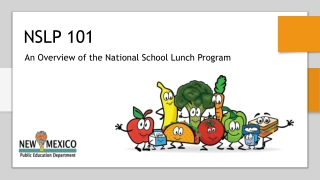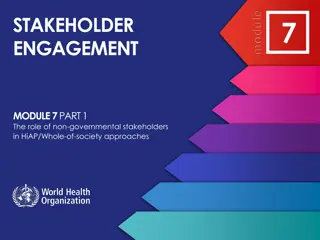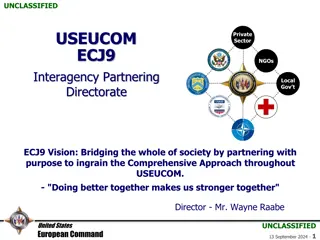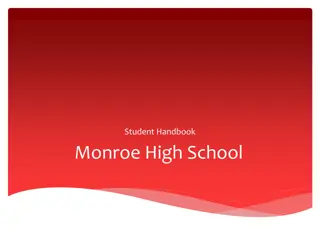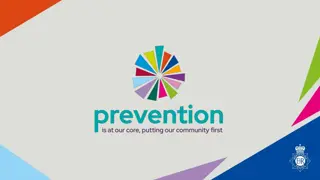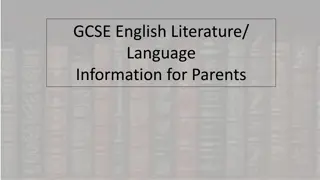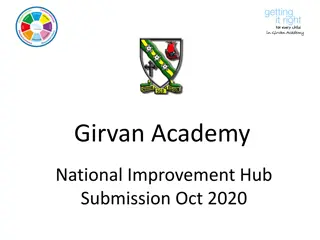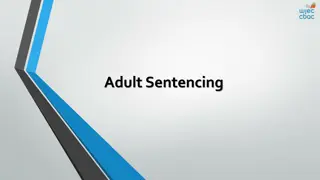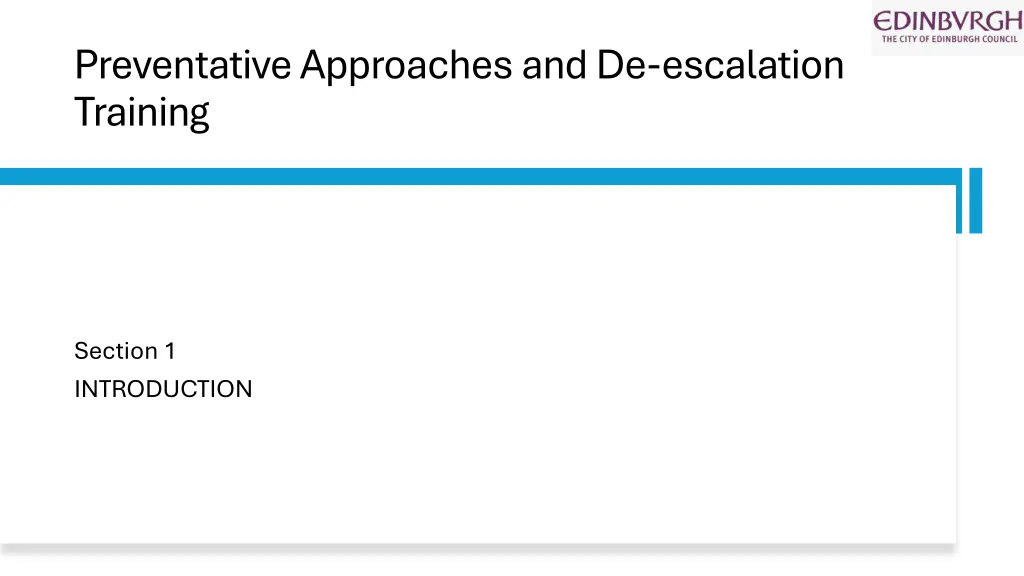
Effective Strategies for Promoting Positive School Relationships
This training program focuses on implementing preventative approaches and de-escalation techniques in educational settings to support children and young people effectively. It aims to improve schools' processes, develop effective strategies, and enhance staff training to manage risk and enhance learning outcomes. By addressing staff responses to challenging behaviors and providing helpful strategies, the training seeks to create a supportive environment for students, staff, and parents/carers to promote positive relationships and engagement in learning.
Download Presentation

Please find below an Image/Link to download the presentation.
The content on the website is provided AS IS for your information and personal use only. It may not be sold, licensed, or shared on other websites without obtaining consent from the author. If you encounter any issues during the download, it is possible that the publisher has removed the file from their server.
You are allowed to download the files provided on this website for personal or commercial use, subject to the condition that they are used lawfully. All files are the property of their respective owners.
The content on the website is provided AS IS for your information and personal use only. It may not be sold, licensed, or shared on other websites without obtaining consent from the author.
E N D
Presentation Transcript
Preventative Approaches and De-escalation Training Section 1 INTRODUCTION
Purpose To support the development of systems, strategies and ethos, enabling schools and education settings to promote Positive Relationships and support children and young people effectively.
Aims Support schools and educational settings in evaluation of current processes and approaches Support school and education settings leadership teams to develop and implement effective planning to support children and young people who may demonstrate distressed/dysregulated behaviours Provide training for staff for their specific context Support schools and educational settings to manage risk Improve learning and teaching
What this training is not A quick fix An easy answer Training on physical intervention
Whats in it for your setting? Identification of staff training needs Helpful strategies fo school staff, learners and parents/carers A reduction of behaviours that challenge Staff skilled and confident in supporting children and young people An improvement in engagement in learning
Responding effectively to behaviour that challenges inconsistent staff responses to learner behaviour Barriers include punitive staff attitudes staff fear of specific learners low levels of staff interaction with learners poor staff morale unclear organisational aims and vision inconsistent implementation and/or lack of clear procedures inconsistent multi-agency working an unwillingness to examine what went wrong learning experiences that do not match learners needs
For any training to be effective we need E.g. Health & Safety, Staff Welfare, Relationships, Learning and Behaviour Strategy Corporate policies and procedures Specific policies and procedures E.g. Managing Risk, Physical Intervention, Exclusion Specific establishment policies E.g. taking account of local needs
Interventions are more likely to be effective if: There are positive relationships between children/young people & staff, staff with each other and school and parents/carers Interventions are targeted at the whole setting not just the individual pupil They are built on existing strengths Activities match the strengths and needs of individual pupils Staff are enthusiastic and flexible in their teaching techniques Staff understand social values of equality, equity and justice and recognise children's rights There are effective assessment record keeping procedures in place.
Consider Consider How well are all these performance elements functioning in your school?
Preventative Approaches and De-escalation Training Section 2 ENSURING A WHOLE SCHOOL APPROACH
Challenge Questions Challenge Questions The activities and questions in this section are designed to help school leaders reflect on the priorities related to relationships and behaviour and address key areas that influence a positive school environment and effective behaviour management. What do you regard as your main on-going priorities in terms of behaviour and relationships in your school/education setting? What do you regard as the key events regarding relationships and behaviour which you always try to keep a close eye on? What Preventative and preventive measures do you still need to put in place?
In your role as a school leader, how would you see In your role as a school leader, how would you see yourself responding to the following scenarios in yourself responding to the following scenarios in your school? your school?
Some Some learners learners have and and meeting meeting these staff staff expertise expertise. . Such involvement involvement. . What each each individual individual pupil the the impact impact of of this have significant significant additional these needs needs does does impact Such learners learners may What steps steps would would you pupil has has their their needs this on on the the life life and additional support impact on on staff may have have partner you take take to needs met met while and work work of of the support needs staff time time and partner agency to ensure ensure that while balancing balancing the school? school? needs and agency that Consider the role of individual staff within the school and the wider Team Around the Child: is everyone agreed responsibilities? have those who work directly with the child been actively involved in developing and implementing the day-to-day planning? on their roles and
Sometimes Sometimes groups school school or or in in the feel feel is is threatening threatening or potential potential to to unbalance would would you you address address this groups of of learners the playground playground in in a a manner or intimidating intimidating. . There unbalance the the school s this difficulty? difficulty? learners can can behave behave inside manner that that others There may may even school s positive positive ethos inside the others may even be ethos. . How the may be a a How Consider whether the Positive Relationships and Learning policy is being implemented effectively in relation to these issues whether the curriculum offer is wide enough, and being adapted to the needs of specific children how these groups can be managed throughout the school
Working Working with additional additional administrative administrative or do do you you organise organise things do do you you organise organise time paperwork paperwork so so that possibilities possibilities for for support? with partner partner agencies agencies can or organisational organisational tasks, to ensure ensure effective effective input? time for for completion completion of of the that you you make make the support? can bring bring about tasks, how input? How the necessary necessary best use use of of the about how How things to the best the Consider how to share strategic remits within and beyond the school leadership team having clarity about who within school is responsible for specific tasks associated with planning, multi-agency liaison, liaison with parents etc
How How do staff staff when when dealing in in your your school? school? I I. .e e. ., , as that that all all staff staff understand play, play, and and it it is is not understanding understanding and learners? learners? do you you ensure dealing with ensure a a collegiate collegiate approach with behaviour behaviour and/or as a a school school leader, understand that that they not just just up up to and problem problem- -solving approach from and/or discipline discipline matters leader, how how do do you they have have a a positive positive role to school school leaders leaders to solving approaches approaches with from your your school school matters you ensure ensure role to to model model to with Consider ensuring those directly involved in supporting the child are engaged in assessment and in creating and managing the planning both for ownership and being enabled to make adjustments based on direct experience and feedback from the child agreeing main points of contact for parents/carers, and enable class teachers and PSAs to take on this role
A A common common problem always always have have time behaviour behaviour and to to link link to to parents How How do do you you approach problem is is that time to to fill and discipline discipline incidents parents and and identify approach this this issue? that teaching teaching staff fill in in the the paperwork paperwork in in connection incidents. . This This can identify Additional Additional Support issue? staff feel feel they connection with can make make it it difficult Support Needs they do do not with difficult Needs. . not Consider a whole school approach to planning for additional support needs an agreed mechanism for logging and debriefing when there are behaviour incidents discussion within Working Time Agreements about the need to identify time for specific tasks ensuring planning is proportionate, realistic, and links assessment directly to actions required of those named in the plan, rather than being onerous in its own right
For For schools schools with with Additional Additional Support Support Needs Needs provision provision. . What is the current structure of your ESB (Education Support Base) in terms of staffing, and is there sufficient emphasis on the quality of learning and teaching? Do you have access to the Additional Support for Learning Service and Educational Psychology Service for guidance on managing learning and behaviour? If so, are you fully utilising these and other partnerships to their potential? How crucial are specialist support and partnerships in addressing issues related to relationships and behaviour within the school? What steps have you taken to create a nurturing environment, such as Creating an Autism-Friendly Environment, and have you used the HNIOS toolkit in this process? How can you enhance learning and engagement through whole-school initiatives like interdisciplinary learning (IDL), play-based learning, outdoor learning, or Learning for Sustainability? What curriculum adjustments might be necessary? What level of understanding do your staff have regarding Trauma-Informed Practice, and what other training needs exist within your specialist area?
School Audit Tool Structures and Systems Leadership Environment Whole School Approach Staff Practice
School Audit Tool School Audit Tool.docx
Evaluating your schools progress in supporting relationships and promoting Evaluating your school s progress in supporting relationships and promoting positive behaviour positive behaviour Qualitative (soft) measures Qualitative (soft) measures Quantitative (hard) measures Quantitative (hard) measures Observation schedules carried out in Observation schedules carried out in different contexts E.g., behaviour in different contexts E.g., behaviour in playground, classroom, lunch hall, playground, classroom, lunch hall, cloakroom, transitions cloakroom, transitions Can be tailored to look at specific Can be tailored to look at specific aspects (e.g., pupil engagement with aspects (e.g., pupil engagement with lessons/emotional responses, staff lessons/emotional responses, staff practice showing nurturing approaches) practice showing nurturing approaches) Parents/carers, pupil, staff views Parents/carers, pupil, staff views gathered through different means gathered through different means Questionnaires Questionnaires School School- -home communications home communications Minutes from meetings Minutes from meetings Child s Plans Child s Plans School records / minutes hold School records / minutes hold evidence of effectiveness of evidence of effectiveness of strategies noted over time strategies noted over time Attendance Attendance Exclusions Exclusions Attainment Attainment Number of children/YP on approved Number of children/YP on approved flexible packages / flexi flexible packages / flexi- -schooling arrangements Instances of positive arrangements Instances of positive feedback / number of parental feedback / number of parental complaints linked to behaviour Number complaints linked to behaviour Number of recorded incidents of of recorded incidents of violent/aggressive behaviour on SHE violent/aggressive behaviour on SHE portal portal Improvement data gathered through Improvement data gathered through application of improvement application of improvement methodology methodology Quality Improvement programmes Quality Improvement programmes schooling
Question framework to measure success Question framework to measure success What is the What is the problem we problem we are trying to are trying to solve? solve? What does current available data suggest? What are we What are we trying to trying to change? change? How will we How will we know it has know it has made a made a difference? difference? Set target, visualise goal/ aim What will we What will we do to do to implement implement change? change? What, when, where, how, who? What will we What will we measure to measure to identify change? identify change? i.e. Areas to further develop nurturing practice Identified data sources. Start and end date of data review.

